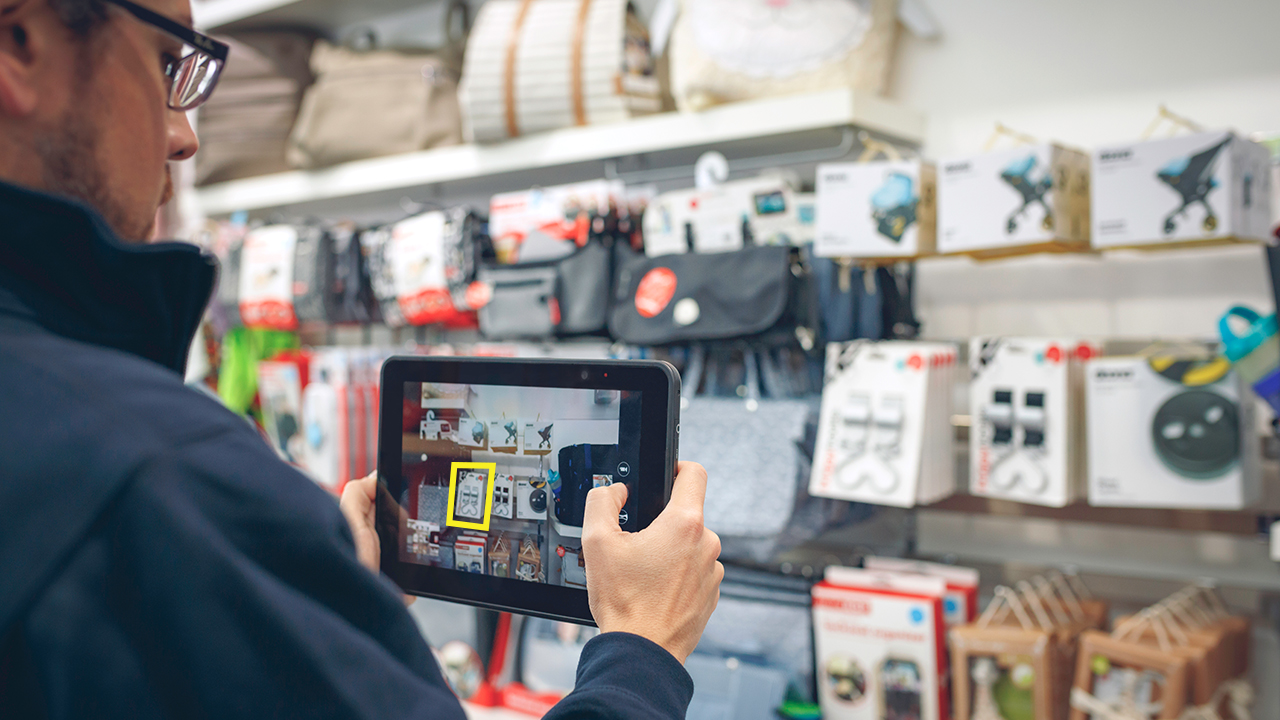
3 Reasons Why Rugged Mobile Devices are the Only Type of Devices Retailers Should be Shopping for Right Now
When retailers choose to give a store associate or warehouse worker a consumer device, you're giving them technology that is meant for talking, texting and playing—not professional use. When designing these devices, manufacturers aren't considering what it takes to be effective and efficient in the retail industry, such as uninterrupted wireless connectivity, integrated barcode scanning capabilities, IT system interoperability and enterprise-level security, not to mention a suitable level of durability.
They don’t really prioritize input/output (I/O) either, which means you may have to “make do” with just one USB port, if that’s even offered. Many consumer device manufacturers are removing I/O ports as fast as enterprise-grade rugged device manufacturers are adding them. (Can you believe that audio jacks are no longer a standard feature on many smartphones and tablets? These used to be table stakes.)
Indeed, the times are changing. Yet, change is the very reason why retailers can’t afford to compromise when it comes to mobility. Mobile devices are the means by which actionable intelligence is shared with retail’s front-line workers so that they can confidently take the “best next action” to keep customers happy, prevent losses and protect revenue. So, the next time you consider trying consumer devices in your retail operations, first stop to consider the many ways you’re “normalizing the risks,” particularly as they relate to these three things:
1. Enterprise-grade rugged mobile devices have longer life cycles.
Manufacturers of consumer devices have a business based on planned obsolescence. In fact, they typically release a new model every year to continue generating profits. What does that mean for you? In short, you aren't getting technology that is built to last.
Rugged devices don't follow a cyclical schedule for new products. They only hit the market when there are significant upgrades and advancements that prove critical to your business, and many rugged device manufacturers will push out functional and security upgrades for remote configurability throughout the devices’ entire lifecycle. (You’ll want to check out this blog on OEMConfig if you haven’t seen it already.)
2. Retail work is rigorous, even in the sleekest of showrooms.
Part of the reason why consumer smartphones and tablets struggle to perform in retail environments is because they aren’t physically built with longevity in mind.
There's a big difference in mobile technology that was made to be used from the comfort of your desk or couch and that which is purpose built to keep you productive on your feet in order to support shoppers’ every need without missing a beat. Besides the fact that a typical consumer device only has an expected life of three years or less – yes, even those marketed as “rugged” – there’s a very good chance that they could be rendered useless much sooner if they can’t handle drops, last for long periods of time without charging or scan barcodes effectively.
And while I can’t speak for all rugged mobile device manufacturers, most take retailers’ needs into account while designing their products. Zebra actually prioritizes them based on direct conversations with retailers. The entire reason why we innovate is to find solutions for the specific challenges of retailers, which are never static, with the past year being a prime example. That is why Zebra rugged devices can serve retail associates and increase productivity, despite shared use and rough handling, for up to ten years.
3. Increased security and easy IT management aren’t inherent in consumer devices.
You know that data protection is extremely important to your business, and a good rugged mobility solution will provide managed access and data encryption, at a minimum, to ensure that personal and private data stays safe.
I think Zebra’s Chief Security Officer, Mike Zachman, explains best what retailers need to think about from a security perspective in these blogs and podcasts:
- These are Today’s Top Enterprise Security Challenges, According to One CSO
- Ask the Expert: How Can My Organization Recognize and Defend Against Internal Security Threats?
- Study: More Companies Are Opening Up Their Networks to Share Data, But They’re Also Doing More to Lock Them Down
- This May Be the Most Overlooked Source of Safety and Security in Your Warehouse
And Nick Sawyer, Global Lead for Zebra’s Managed and Support Services Regional Portfolio Management team, perfectly articulated the benefits of enterprise-grade mobility solutions from a managed services perspective in his last blog post.
These two are experts in this space and have a great deal of experience in working with retailers specifically. Please do heed their advice.
Yes, you can put a rugged case on a consumer-grade mobile device and cross your fingers that it won’t break, and maybe it won’t. But there’s no security “case” or mobile device management solution that will give you the level of visibility and control you need to protect your operational intelligence and, just as important, your customers’ personal data.
Retailers are already reported to be the least-trusted company/institution when it comes to data security, per the feedback received from our 2020 Shopper Study. Only 12 percent of consumers “completely trust” that you’re going to protect their personal data. Take advantage of the many different security tools offered with enterprise-grade rugged devices – tools that aren’t available for consumer devices, no matter how many services you add on.
If nothing else, investing in enterprise-grade rugged devices from the start will keep your IT budget from ballooning out of control since they are typically equipped with enterprise software components that go beyond what is available within the OS environment “out of the box” to help you configure and secure your devices. It’s the thoughtfully integrated tools such as Zebra’s Mobility DNA and Lifeguard that make life so much better for the developers and IT folks who have to manage the devices.
And that leads me to my final point…
Whatever you do, don’t look at the “total cost” of ownership first. Consider the “total benefits” of ownership above all else.
I know, this is a glass half full/half empty scenario. Technically, considering the “total benefits of ownership” is just another way to calculate the “total cost of ownership.” Yet, I like talking about this equation in terms of the “total benefits” simply because there are tangible and intangible factors at play, some of which are more qualitatively weighed. And at the end of the day, it’s the business outcomes that are most important to you. For example, you can objectively calculate the cost to buy a handheld computer or tablet. You may even be able to put a hard number on the implementation services. But it may be challenging to calculate the value gained when that mobile device works perfectly, enabling your store associates to deliver the personalized experience shoppers expect to help close a sale or garner loyalty.
It can be just as difficult to calculate the financial losses suffered by a device failure, or even subpar performance. If it takes too long for an associate to check inventory for additional size or color options and the customer abandons their potential purchase, how do you quantify that? Maybe there’s a way to put a number to that scenario. Or, you could consider the benefits you gain from ensuring that scenario never happens, because you have reduced the risk of failure and increased the likelihood that your associates’ mobile devices will also work as they need them to by giving them devices that were purpose built and proven to perform to retails’ high standards.
(If you’re someone that needs numbers to justify a technology recommendation to decision makers, there is an independent 2018 VDC Research study that shows rugged mobile devices cost half as much as consumer devices over a 5-year period, primarily due to longer life cycles, reduced loss of worker productivity and lower IT administrative overhead.
Don’t Forget: Your Store Associates Aren’t the Only Ones Using Your Devices
If you offer a Personal Shopping Solution (PSS) or kiosk-based services in your stores, you need to ensure the mobile computing devices can withstand constant handling by busy, distracted shoppers and sticky fingers. I’m talking about those who may have lotion or food residue on their hands or coffee in their hand, not thieves. Although, it is critical that you have a way to track and lockdown a device that may have accidentally walked out of the store. Again, people are busy and we’re creatures of habit. It’s not unusual for someone to accidentally put a device in their purses or pockets when they’re done with it just because that’s what they normally do with their personal devices dozens of times a day.
Simply put, technology designed for use by the consumer mass market isn't made to meet the demands of the retail industry. Opting for rugged devices that are built for today's retailers provides associates with a reliable tool to accomplish their most important jobs: providing excellent customer service and keeping the business profitable.
###
Editor’s Note:
Check out this infographic to understand some of the other Total Benefits of Ownership of enterprise-grade rugged devices in retail environments.

Mark Thomson
What’s happening in retail? How has the shift in shopping behavior impacted retailers around the world and will robots take over? Mark Thomson’s exploration of the global retail landscape helps retailers gain a focus on what’s real and what works when building a retail strategy in a digital world.
As Director of Retail Industry Solutions at Zebra Technologies, Mr. Thomson works closely with retailers and hospitality businesses to provide input on how to face the challenge of a new digital retail landscape, where customers are often more connected and informed than shop floor staff. Mr. Thomson helps retailers focus on developing a vision for their retail business that aims to improve customer experience and drive business efficiencies.
With over 27 years of customer-focused experience, Mr. Thomson has developed in-depth knowledge of the EMEA and global retail marketplace and regularly speaks at industry events throughout the EMEA region including World Retail Congress, Retail Middle East, RBTE and Euroshop. He has worked closely with retailers on the pain points of modern retail and explains how technology solutions can be an integral part of their business strategy to help them solve their real business challenges from supply chain to store.
Prior to joining Zebra, Mr. Thomson held senior roles in Financial Services and Hospitality businesses.




